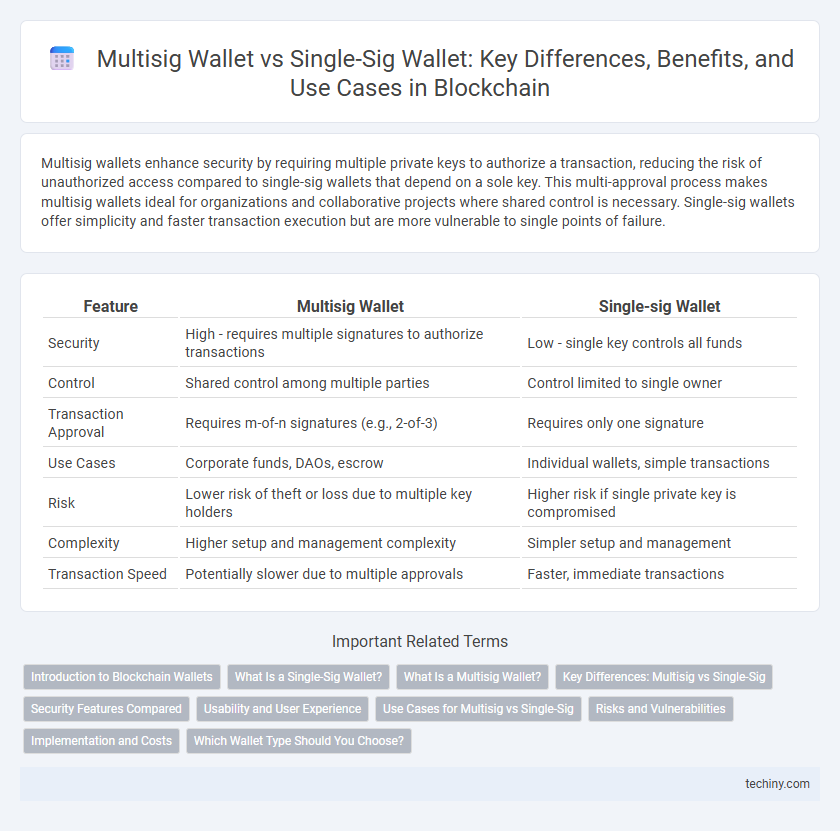Multisig wallets enhance security by requiring multiple private keys to authorize a transaction, reducing the risk of unauthorized access compared to single-sig wallets that depend on a sole key. This multi-approval process makes multisig wallets ideal for organizations and collaborative projects where shared control is necessary. Single-sig wallets offer simplicity and faster transaction execution but are more vulnerable to single points of failure.
Table of Comparison
| Feature | Multisig Wallet | Single-sig Wallet |
|---|---|---|
| Security | High - requires multiple signatures to authorize transactions | Low - single key controls all funds |
| Control | Shared control among multiple parties | Control limited to single owner |
| Transaction Approval | Requires m-of-n signatures (e.g., 2-of-3) | Requires only one signature |
| Use Cases | Corporate funds, DAOs, escrow | Individual wallets, simple transactions |
| Risk | Lower risk of theft or loss due to multiple key holders | Higher risk if single private key is compromised |
| Complexity | Higher setup and management complexity | Simpler setup and management |
| Transaction Speed | Potentially slower due to multiple approvals | Faster, immediate transactions |
Introduction to Blockchain Wallets
Multisig wallets require multiple private keys to authorize a transaction, enhancing security by distributing control among several parties. Single-sig wallets rely on a single private key for transaction approval, making them simpler but more vulnerable to hacking or loss. Blockchain wallets store cryptographic keys that enable users to access and manage their cryptocurrency assets securely on the blockchain network.
What Is a Single-Sig Wallet?
A single-sig wallet is a type of cryptocurrency wallet that requires only one signature or private key to authorize transactions, making it simpler and quicker for individual users to manage their digital assets. It offers straightforward control but is more vulnerable to security risks since if the single key is compromised, the funds can be easily accessed by unauthorized parties. Single-sig wallets are ideal for users who prioritize convenience and speed over multi-layered security measures found in multisig wallets.
What Is a Multisig Wallet?
A multisig wallet requires multiple private keys to authorize a blockchain transaction, enhancing security by distributing access control among several participants. Unlike single-sig wallets, which depend on one private key, multisig wallets mitigate risks associated with key loss or theft. This multi-signature approach is essential for organizations and collaborative projects seeking robust protection against unauthorized transactions.
Key Differences: Multisig vs Single-Sig
Multisig wallets require multiple private keys to authorize a transaction, enhancing security by preventing single points of failure, whereas single-sig wallets depend on one key, making them more vulnerable to unauthorized access. Multisig wallets are ideal for organizations and shared accounts due to their added control and accountability, while single-sig wallets offer simplicity suited for individual users. The key difference lies in multisig's ability to require a threshold of signatures, improving security and reducing risks compared to single-sig's sole reliance on one signature.
Security Features Compared
Multisig wallets enhance blockchain security by requiring multiple private keys for transaction authorization, significantly reducing the risk of unauthorized access compared to single-sig wallets that depend on a single private key. This multi-signature feature mitigates vulnerabilities such as key theft, phishing, and accidental loss by distributing control among several participants. Single-sig wallets, while simpler and faster, present a higher attack surface due to reliance on one key, making multisig wallets the preferred choice for institutional investors and high-value asset storage.
Usability and User Experience
Multisig wallets enhance security by requiring multiple signatures to authorize transactions, reducing the risk of unauthorized access compared to single-sig wallets that rely on a single private key. While multisig wallets offer robust protection, their step-by-step transaction approval process can introduce complexity, potentially impacting user experience for non-technical users. Single-sig wallets provide faster, more straightforward transaction management but sacrifice the layered security benefits inherent in multisig configurations.
Use Cases for Multisig vs Single-Sig
Multisig wallets enhance security by requiring multiple private keys to authorize transactions, making them ideal for organizational funds management, joint accounts, and escrow services where multiple approvals mitigate the risk of fraud. Single-sig wallets suit personal use cases with simpler, faster transactions but are more vulnerable to single-point key compromise. In decentralized finance (DeFi), multisig wallets support governance models by enabling collective decision-making, whereas single-sig wallets are favored for straightforward, individual asset control.
Risks and Vulnerabilities
Multisig wallets enhance security by requiring multiple private keys to authorize a transaction, significantly reducing the risk of unauthorized access compared to single-sig wallets that rely on a single key, making them more susceptible to theft or loss. However, multisig wallets face vulnerabilities like key management complexities and the potential for increased transaction delays if one or more key holders are unresponsive. Single-sig wallets suffer from a single point of failure, where loss or compromise of the private key results in total asset loss, highlighting the trade-off between ease of use and security robustness.
Implementation and Costs
Multisig wallets require multiple private keys to authorize transactions, enhancing security but increasing implementation complexity compared to single-sig wallets, which need only one key. Deployment of multisig contracts demands higher gas fees on blockchain networks due to multiple signature verifications, whereas single-sig wallets incur minimal transaction costs. Developers must balance security needs against operational expenses, as multisig solutions provide robust protection at the price of increased resource consumption and setup time.
Which Wallet Type Should You Choose?
Choosing between a multisig wallet and a single-sig wallet depends on your security needs and transaction complexity. Multisig wallets require multiple private keys to authorize a transaction, enhancing security and reducing the risk of unauthorized access, making them ideal for organizations or joint accounts. Single-sig wallets rely on a single private key, offering simplicity and quicker access suitable for individual users with lower security requirements.
Multisig Wallet vs Single-sig Wallet Infographic

 techiny.com
techiny.com